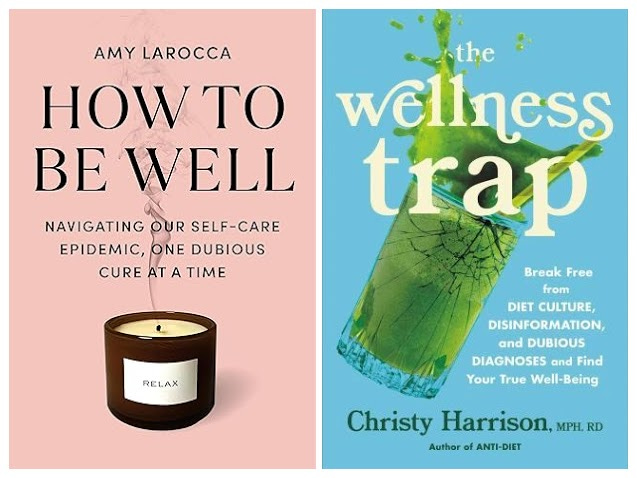Taking Aim at the Wellness Industrial Complex
How to Be Well by Amy Larocca and The Wellness Trap by Christy Harrison
As a White, middle-aged woman of moderate means, I am a prime target of the wellness industry. Snake oil salespersons of many stripes have found their way to my social media feeds, and I’ll admit that I’ve been a sucker to various wellness claims over the years. Perhaps that is why two books jumped out at me while perusing the stacks at my local bookstore.
I first came across The Wellness Trap: Break Free from Diet Culture, Disinformation, and Dubious Diagnoses — and Find Your True Well-Being by Christy Harrison, MPH, RD when I was preparing to teach a course in health psychology. In the book, Harrison’s states the following goal:
“. . . to offer a model for thinking critically about the wellness information you encounter, in order to help you avoid falling prey to toxic ideas about toxins, noxious beliefs about inoculations, and all the other dubious diagnoses and spurious cures proliferating every day.”
Harrison, who also authored Anti-Diet: Reclaim Your Time, Money, Well-Being, and Happiness Through Intuitive Eating, sees many parallels between diet culture and the wellness industry. She explains how the industry equates wellness with moral goodness and how it over-sells the role of individual responsibility for one’s health. Harrison addresses the social determinants of health and refers to wellness as “the relentless pursuit of the apex of health, in a way that only people who are rich in both time and money can truly afford.”
______
I recently discovered How to Be Well: Navigating Our Self-Care Epidemic, One Dubious Cure at a Time while working on my sabbatical study of teacher well-being. (The terms wellness and well-being are distinct, with the latter term more generally associated with healthy psychological functioning.) In my work with teachers, I want to stay clear of pseudoscientific advice.
In the book, author Amy Larocca provides a scathing critique of the $5.6 trillion wellness industry. Unlike Harrison who is a registered dietician nutritionist, Larocca approaches a critique of the wellness industry as a journalist in a different, but equally adept, fashion.
Every wellness trend is up for Larocca’s scrutiny, including her own experiences dabbling with various cleanses and cures. She offers an insightful history on how our current conception of self-care entered the zeitgeist in the early 1970s. With a journalistic flair, she exposes wellness gurus in a chapter entitled, “Kooks.” She also pokes fun at how our sex lives have new pressures from wellness-world dictates and throws shade on the endless pursuit of biohacking.
______
Both books take aim at some common targets: Gwyneth Paltrow and her goop lifestyle brand, the anti-vaxxer movement, and various remedies that are touted as “clean and natural.” But the different backgrounds and diverse perspectives of both authors makes reading these books a one-two punch against many of the false promises of the wellness industry. And as a scientist, as well as a common target for wellness world crap-crappery, I am here for all of it.


